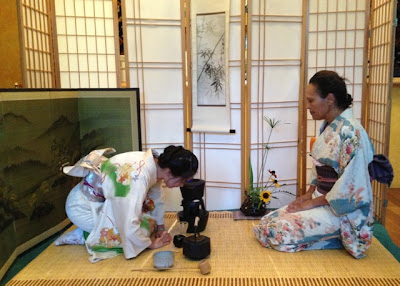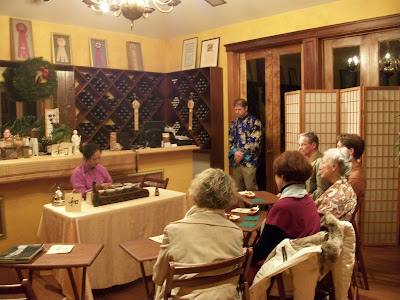2012年9月20日星期四
Tea tasting class
Do you know how to taste tea? We had a tea tasting class at the Swan Tea House.The class helped to build a student's sensitivity to view, to taste, and to smell tea like a educated person.
2012年8月18日星期六
2012年7月28日星期六
Chinese Tea Ceremony
Tea Ceremonys
1-18-2012 Tea Ceremony
1-18-2012 Tea Ceremony
Chinese tea ceremony is quite a different way to drink tea than either traditional English style or Japanese tea ceremony.
Chinese tea culture refers to the methods of steps preparation of tea and serving the tea, the equipment used to make tea and the occasions in which tea is consumed in China. The terms chayi "Art of Tea 茶藝" and "Tea Ceremony" have been used, but the term "Tea Culture茶文化" includes more than just the ceremony. Also "culture" is easier to translate into English from the Chinese term "art 藝".Chinese tea ceremony is about art, elegance 雅and harmony和.(Respect敬、Pure清、Silent寂、honest and clean廉、simplicity俭、beauty美、happy乐、quiet静)
Tea culture in China differs from that of Europe, Britain or Japan in such things as preparation methods, tasting methods and the occasions for which it is consumed. Even now, in both casual and formal Chinese occasions, tea is consumed regularly. In addition to being a drink, Chinese tea is used in traditional Chinese medicine and in Chinese cuisine.
2012年4月30日星期一
Chinese Tea Culture Festival
Chinese Tea Ceremony
doing Yunnan dance
Serve Yunnan Pu-er Tea
Serve Tea Snack and Tea
2006 in China in Shanghai
2012年4月11日星期三
TEA TASTING FORMULA
The same tea leaves can produced different tea according to different tea-making processes. Each method of preparation provides an individual taste. However, to ensure the quality of any given tea variety, the following six steps should be adhered to.
1. THE BREW
Put in 3 grams of tea leaves to a tasting cup, pour in 150cc of boiling water, steep for 5 minutes and pour out the tea to a tasting bowl. This is a universal formula to determine the quality of the tea.
2.CHECK THE AROMA
Sniff the aroma of the brewed tea leaves to ascertain the pureness of the tea.
3.CHECK THE COLOR
Look for the translucent shine in the brewed tea. Good tea should be bright and rich in color.
4.TASTE THE TEA
Sip a little bit to descern the strength, smoothness and sweetness of the tea infusion. The preferred taste is smooth sweet and rich.
5.CHECK THE TEA LEAVES
Check the tea leaves after brewing for signs of freshness and tenderness.
6.CHECK THE DRY TEA LEAVES FOR QUALITY
having tasted and checked the brewed tea, examine the dry tea leaves to assess their quality. Good tea leaves are of even sizes and tightly folded with fine lustre.
this is from 《A PASSAGE TO CHINESE TEA》
2012年4月9日星期一
历代饮茶法 CENTURIES OF PRESER VATION AND SAVOURING OF TEA IN CHINA
历代饮茶法
CENTURIES OF PRESER VATION AND SAVOURING OF TEA IN CHINA
TANG DYNASTY
Before Lu Yu, tea was brewed with other ingredients, thus losing its original flavour. Later, upon his advice, compressed leaves were crushed before brewing which resulted in obtaining its true essence.
SONG DYNASTY
The curing technique was refined and tea leaves were crushed and placed in bowls before boiling water was poured over it. The infusion of heat and tea leaves brought out the distinctive of the tea taste.
YUAN AND MING DYNASTY
Tea was produced in loose form instead of the old compressed cake form. Crushing the tea leaves became unnecessary. Tea was brewed directly using the loose leaves.
QING DYNASTY
From Ming to Qing onwards, tea was brewed in small clay teapots, which continues to this days.
all from 《A PASSAGE TO CHINESE TEA》
2012年4月7日星期六
Lily's Tea Garden: SEVEN CUPS OF TEA
Lily's Tea Garden: SEVEN CUPS OF TEA: The first bowl moistens my lips and throat; The second bowl banishes all loneliness; The third expelled the dullness from my mind,...
SEVEN CUPS OF TEA
The first bowl moistens my
lips and throat;
The second bowl banishes all
loneliness;
The third expelled the
dullness from my mind,
Inducing inspirations born
from all the books I’ve read;
At the fourth cup, I begin
to perspire –
life's troubles evaporate through
my pores.
The fifth cup cleanses my
entire being.
Six cups and I am in the
realm of the Divine.
Seven cups - ah, but I can
drink no more:
I can only feel the gentle
breeze blowing through my sleeves,
wafting me away to the Isle
of Immortality!
Lu
Tung, 8th century Taoist poet
一碗喉吻润,两碗破孤闷。
三碗搜枯肠,唯有文字五千卷。
四碗发轻汗,平生不平事,尽向毛孔散。
五碗肌骨清,六碗通仙灵。
七碗吃不得也,唯觉两腋习习清风生。
蓬莱山,在何处?
玉川子,乘此清风欲归去。
——唐代 卢仝
2012年1月22日星期日
2012年1月21日星期六
茶源 THE ORIGINS OF TEA
茶源
THE ORIGINS OF TEA
THE DISCOVERY OF TEA – EARLY USES
At the dawn of creation, there must have been tea shrubs growing in the wild, waiting to be discovered.
It was said that the Emperor Shen Nong first discovered tea in China. He found the leaves edible, drinkable when brewed and even to possess healing powers. Thus began his fascinating search to identify and classify tea variety and quality. He painstakingly tasted innumerable species of herb and shrub, notified their healing properties and recorded them for posterity.
As legend has it, Shen Nong accidentally tasted a type of poisonous weed which could kill a man within ten steps. Only tea leaves could save him. But before he could reach any tea bushes, the poison took effect. He died within his seventh step. It was a great tradegy. But without his discovery TEA as is known worldwide now may not have such an illustrious journey in history down to the present time. It is not only a general beverage found in every corer of the world, but it has become part of the lifestyle of many nations. For the Chinese it is a cultural tradition practiced daily and on special ceremonial occasions. It is offered to both the dead and the living. Tea is served as a mode of respect, goodwill, acceptance, blessing and friendship. It is presented at weddings, births and burial ceremonies. In any Chinese household it is an accepted courtesy to serve tea to visitors and guests on entering the house.
As legend has it, Shen Nong accidentally tasted a type of poisonous weed which could kill a man within ten steps. Only tea leaves could save him. But before he could reach any tea bushes, the poison took effect. He died within his seventh step. It was a great tradegy. But without his discovery TEA as is known worldwide now may not have such an illustrious journey in history down to the present time. It is not only a general beverage found in every corer of the world, but it has become part of the lifestyle of many nations. For the Chinese it is a cultural tradition practiced daily and on special ceremonial occasions. It is offered to both the dead and the living. Tea is served as a mode of respect, goodwill, acceptance, blessing and friendship. It is presented at weddings, births and burial ceremonies. In any Chinese household it is an accepted courtesy to serve tea to visitors and guests on entering the house.
订阅:
博文 (Atom)





































